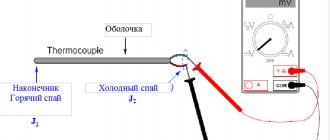In the household, problems arise when installing sockets and switches, connecting lighting systems, household electrical appliances and other similar devices. They are usually powered from single-phase sources, the wires of which consist of two conductors - phase and neutral. In a safer option, a third wire is added to them - ground or grounding.
Most household electrical appliances function normally when the conductors are connected strictly according to the operating diagram. The basis for successfully resolving the issue will be the skills of determining where the phase is and where the zero is. You can do this fairly simple job yourself, without involving electricians, and therefore save on financial costs.
There are ways to find phase and zero, both with and without the use of instruments.
The concepts of “zero” and “phase”
Electric current is the ordered movement of negatively charged particles.
If electrons move in only one direction, such a current is called constant; if in different directions, it is called alternating.
There are three types of conductors:
- “Phase” is a working contact. Voltage is applied to it.
- “Zero” (“zero”) is the conductor through which current flows back to the generator, completing the circuit.
- “Ground” is a wire connecting any point in the network to a grounding element. It is needed to protect against electric shock.
Why do you need a partner?
As you know, when working with electricity you need to take as many safety precautions as possible. Another practical advice from experts is to repair electrical wires with a partner.
The person chosen for this role may well not understand anything about electrical circuits. However, he must clearly know what to do if someone comes under voltage: pull the person by the clothes, without touching his body, away from the live wire.
It is advisable to first unbutton the jacket that you are wearing to protect your hands before making connections in the electrical panel. This is vital. The fact is that a free part is formed on the back, by which a person can be pulled away in the event of an electric shock. It will be convenient for your partner to grab onto it. Your partner should also remember how to call an ambulance or emergency services.
The help of a partner can be invaluable when the shield is located high. He will be able to give or receive tools. This way, you won’t have to constantly go down and get up again from a stool or stepladder.
Why is it important to correctly identify the phase wire
When connecting devices to the network, a working “phase” conductor is used. Voltage is supplied directly to the consumption source. It would be a mistake to connect the receiver to “zero”, because when the circuit is opened (the device is turned off), the network still remains energized. This can be clearly seen if you connect a light bulb switch to the neutral wire. In this case, the cartridge is constantly under voltage. This connection is dangerous when it is necessary to change the lamp or the lampshade itself.
It is important to correctly identify the phase wire.
Why do you need a partner?
As you know, when working with electricity you need to take as many safety precautions as possible. Another practical advice from experts is to repair electrical wires with a partner.
The person chosen for this role may well not understand anything about electrical circuits. However, he must clearly know what to do if someone comes under voltage: pull the person by the clothes, without touching his body, away from the live wire.
It is advisable to first unbutton the jacket that you are wearing to protect your hands before making connections in the electrical panel. This is vital. The fact is that a free part is formed on the back, by which a person can be pulled away in the event of an electric shock. It will be convenient for your partner to grab onto it. Your partner should also remember how to call an ambulance or emergency services.
The help of a partner can be invaluable when the shield is located high. He will be able to give or receive tools. This way, you won’t have to constantly go down and get up again from a stool or stepladder.
Methods for determining the working “phase” and “zero” using instruments
The conductor with the working “phase” has the same voltage as in the outlet: 220V. It is necessary for the functioning of household electrical appliances. In the neutral conductor the current voltage is very weak. Identification of wires is carried out by elimination method as soon as phase contact is detected.
There are several ways to determine the “phase”: by the color of the wires, by letter markings and using instruments - an indicator screwdriver and a multimeter.
Indicator screwdriver
The design of the screwdriver ensures its convenient and safe use.
The voltage value cannot be determined using an indicator screwdriver - it only shows its presence in the conductor.
Before checking the voltage, you need to perform a number of manipulations for safety:
- de-energizes the network;
- strip the wires of insulating material;
- separate the ends of the wires from each other as far as possible to avoid a short circuit;
- turn on the current in the network.
The indicator screwdriver shows the presence of current in the conductor.
The diagnosis itself is very simple:
- You need to touch the bare wires one by one with the tip of the tool. At the same time, you need to hold the screwdriver by the handle with your thumb and middle finger. It is dangerous to touch the metal rod during the test, because current passes through it.
- At the same time, use your index finger to press on the metal tab at the end of the screwdriver. By touching the contact pad, a person acts as an element of the circuit, grounding it. If there is voltage in the conductor, the LED light will light up; otherwise, the conductor is neutral.
A resistor is built into the design of the indicator screwdriver, which limits the current to a value safe for humans. Using a spring, it transmits a signal to the light bulb.
This method is especially convenient when checking sockets, since the tip of the screwdriver allows you to quickly reach the contact.
Multimeter
Using a multimeter, all characteristics of the electrical network are measured. Accordingly, it also shows the presence of voltage in the conductor. In addition, the device determines the nature of each wire - “ground”, “zero” and “phase”. It is possible to measure voltage on any part of the circuit, be it a panel, socket or cable.
Procedure:
- To check the phase, set the device to “Alternating voltage” mode. Select the maximum permissible limit: 600-750 V.
- One probe of the multimeter is held between the fingers, and the other is touched to the contact. Insignificant voltage readings will correspond to “zero”, and numbers close to 220 V characterize “phase”.
When an electrician, when checking, clamps one probe with his fingers, it does not receive an electric shock due to the fact that the multimeter has a large input internal resistance, and the currents are hundredths of a milliampere.
Due to internal resistance in the device, different models may show different numbers. But this is not critical.
The multimeter measures all characteristics of the electrical network.
It is important not to confuse the modes when testing. If the examiner accidentally selects "Current Measurement" and touches one of the probes with their hand during identification, they will receive an electrical shock.
It is not necessary to clamp the probe with your fingers for grounding purposes. Some outlets already have a ground contact installed. A metal heating system pipe can also serve this purpose, and electricians often use it.
Having determined the “phase” using a tester, calculating “zero” and “ground” becomes easier.
If you touch the “phase” with one probe and the “zero” with the other, the device will show 220 V. And when the “phase” and “ground” are closed, the value will be much less than 220 V.
Briefly about the home electrical network
As a rule, a single-phase electrical network of 220V and 50Hz is supplied to private multi-storey housing. Powerful three-phase lines are laid to the common distribution panels of high-rise buildings, which are then redistributed into one phase and zero for each consumer (apartment).
When constructing and equipping new housing, they also practice laying a grounding loop, because it is necessary for the safe operation of most powerful household appliances.
Accordingly, the connection to a socket or light bulb, as a rule, necessarily contains two wires - phase and neutral, and can be supplemented with a grounding conductor.
The supply of private houses is carried out according to the same principle, but quite often a three-phase supply with a voltage of 380V directly to the home is practiced. Moreover, some consumer items, such as heating boilers or machine tools from a home workshop, require precisely this powerful voltage.
However, even in this case, the user network is redistributed, evenly dividing the load into single-phase lines. A standard household outlet is powered exclusively by two or three (grounded) wires.
Home electrification. Distribution panel Source elektromontazh.ru
The use of a grounding wire in a household electrical network is clearly recommended by all experts, especially for private buildings.
Alternative methods without the use of instruments
If the situation is such that there is neither an indicator screwdriver nor a multimeter, but it is necessary to find out which contact is phase, use a visual method for determining the contact.
On the cable there is often a letter designation of the characteristics of the conductors. So, the letter L is assigned to the “phase”, N to the “zero”, and PE to the “earth”.
Sometimes electricians during installation additionally mark the phase wire with a hanging tag with a designation. But a simpler solution is color coding of wires. Connecting them correctly (in accordance with the standard) subsequently makes the work of electricians easier, allowing them to quickly navigate the wiring.
By wire color
The colors of the wire insulation are selected so that they differ as much as possible from each other:
- The "phase" is often white, black or brown.
- “Zero” - blue and its shades.
- "Earth" - yellow-green.
But the standards for connecting conductors are not always observed. Therefore, for the sake of safety, it is better to check the voltage in the wires, regardless of their visual markings.
Wire marking standard
Using a control lamp
This method is considered the most risky, but it helps out in situations where the usual testers are not at hand. The inspector needs a lamp twisted into a socket from which 2 wires come out. To safely use such a “device,” it is better to attach probes to the ends of the wires and wrap the lamp itself with a protective casing.
You need to touch the metal pipe (or other grounding element) with one lamp tap, and check the contact with the other. If the lamp lights up, then the contact being diagnosed is “phase”.
Conductors can also be identified by exclusion:
- Alternately touch the lamp taps to two of the three contacts that need to be identified. If the lamp is on, it means that the “phase” - “zero” pair is engaged at this moment.
- To determine the phase and neutral conductors, one of the tester taps is used to touch the next of the three contacts being tested. The light goes out when disconnected from the “phase”. But this will only happen if a circuit breaker is installed in the network. If it is absent, the indicator lights up even in the “ground” - “zero” position.
- To identify the “ground”, if a circuit breaker is not installed, remove the ground from the cable and repeat the test. Now the lamp will not light on this conductor.
Assembling a control light at home is not difficult. To do this, you will need 2 conductors connected to the socket, and the light bulb itself screwed into it.
For safety reasons, it is better to use a neon lamp, and electricians recommend attaching probes to the wires - this will secure and facilitate the operation of the “control”.
Since the light bulb method is unsafe, it is best to avoid it.
Control potato
The most unusual method of determining the phase will require 2 wires and potatoes. 2 conductors are inserted into a tuber cut in half at the maximum distance from each other. One is placed over something grounded (a heating system pipe), the other is placed over the contact being tested. After 5-10 minutes, inspect the potato cut. If a spot appears on it, then the conductor being tested is a “phase”. If there is no spot - “zero”.
Briefly about the main thing
The question of how to determine where the phase is and where the zero is in the wires is quite common and important for many ordinary people, because not in all cases it is necessary to call an electrician. To determine this, you will need minimal skills in using simple measuring instruments, knowledge of the basics of electrical work and following basic safety rules. In fact, it all comes down to knowing the color coding of wiring in electrical cables, purchasing and learning to use an indicator screwdriver or a multimeter (tester).
Ratings 0
Useful tips and general recommendations
Working with electrical wiring requires care and caution.
Electricians advise:
- Do not rely entirely on the color differentiation of wires or their markings; check the contacts with testers again. Cases of violation of electrical installation standards are not uncommon.
- If possible, avoid determining the voltage in conductors using a “tester” or a potato. Such methods are considered extreme, and it is better not to abuse them without experience.
- When using a multimeter, read the instructions in detail before use. Pay attention to the device settings.
Installing wiring according to standards will facilitate further connection of receivers and extend the service life of the entire electrical network. In addition, compliance with the necessary installation standards will make electricity consumption comfortable and safe.
How more complex, active indicator screwdrivers work
The simplest indicator screwdrivers use the contact measurement method, that is, to determine the presence of voltage, you must touch the tip to the conductor. This is quite convenient, but does not solve most of the problems that electricians face when troubleshooting electrical networks.
instruction manual for indicator screwdriver (click to enlarge)
More advanced models of indicator screwdrivers can work in a non-contact manner - they respond to the electromagnetic field that arises in any conductor when electric current flows through it. The design of such postcards is much more complicated - they already have their own circuit and separate power supply. Most are equipped with sound indication. Indicator screwdrivers with an LCD screen are a separate category - such models can even show what voltage is in the network being measured.
The principle of operation is very simple - there is a coil in the screwdriver and when it enters the field around the conductor, an electric current appears in it, which causes the indicator lamp to light up and the buzzer to sound. This property of non-contact indicator screwdrivers allows you to find breaks in the wiring even through the wall - without such a device you would have to completely remove the wallpaper and knock down the plaster wherever the wire is laid.
Before using an indicator screwdriver with the ability to non-contactly determine the presence of voltage, you must remember to turn on their power - so that the battery does not run out, they have a switch.
You can learn how to use this indicator screwdriver by watching this short video instruction:
In addition to indicator screwdrivers, there are other types of voltage detectors, which you can learn about by reading this article.
Application of incandescent lamp
This is a method of using an incandescent lamp to identify the appropriate colored conductors in a 3-conductor network. This method requires compliance with increased security measures.
To use this method, a regular incandescent lamp is screwed into the socket. Wires that do not have insulation at the ends are screwed onto the cartridge terminals.
If you don't have the parts kit for this method, you can use a standard table lamp. In this case, in order to get the result, you should alternately connect the conductors to the plug by color.
The disadvantage of this method is that by using it, it will be impossible to know for sure which of the two conductors is phase. That is, with this method, we rather check the system for performance.
And the advantage is that with a high degree of probability we will know the following: 1 wire is neutral, the other wire is phase. If the light does not light up during testing, this indicates a lack of phase in the conductors being tested.
General information
In our daily lives, we encounter electricity almost everywhere we go. Whether it’s work or various institutions: cinema, theater, shops, sports complexes - the list could go on for a very long time. Needless to say, we use many electrical appliances every day, and 20 or 30 years ago there were not as many of them as there are now. Moreover, their number is growing with enviable frequency.
But all electrical equipment cannot work forever and sooner or later it begins to break down, which is simply inevitable. No one has yet invented a perpetual motion machine, so you shouldn’t hope for a miracle. Some people want to learn something new, unknown, and electricity is no exception. If only because you can carry out repairs of household appliances yourself. Of course, it is better to invite a specialist, but you can do light work yourself. Only for this it is necessary to study fundamental concepts in order to understand what zero and phase are.











